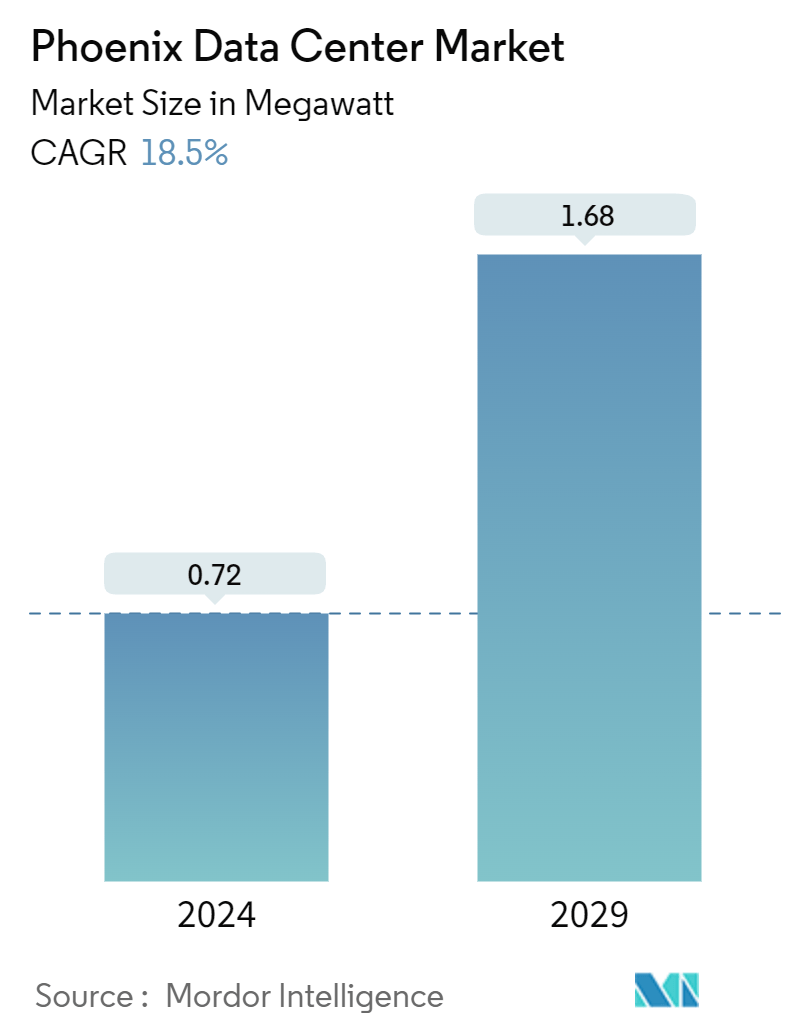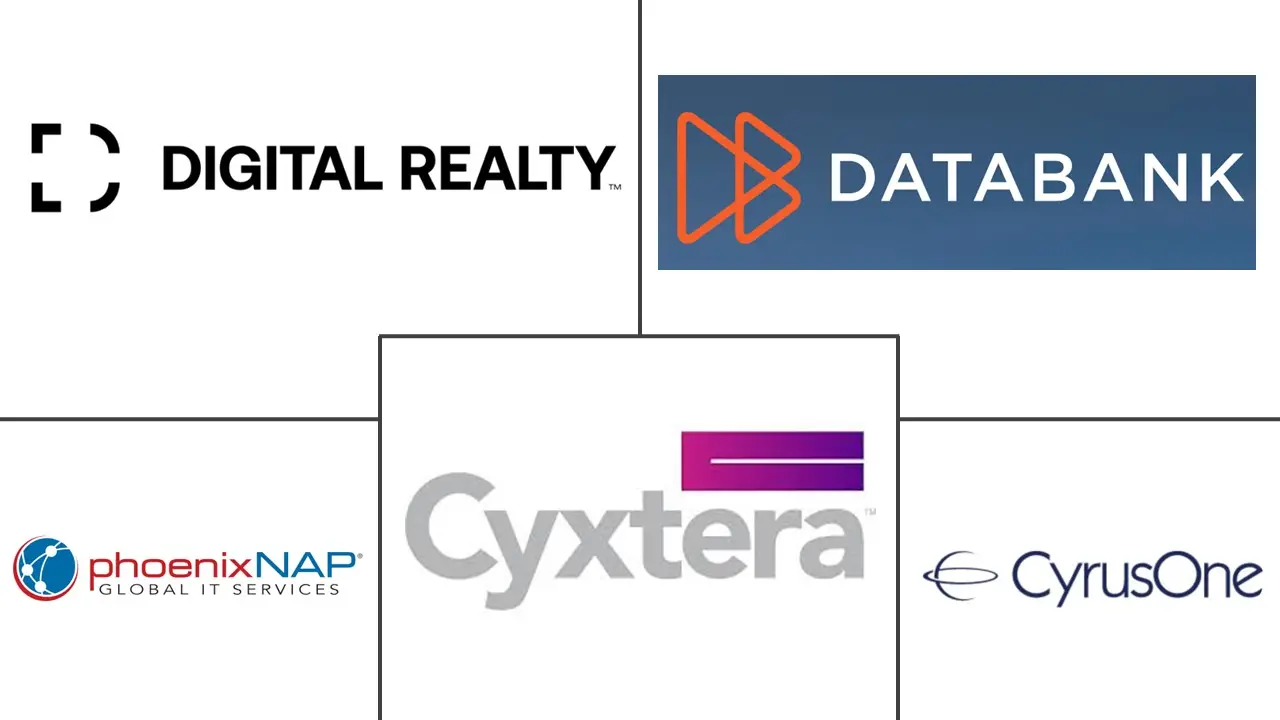Market Size of Phoenix Data Center Industry

| Study Period | 2019 - 2029 |
| Base Year For Estimation | 2023 |
| Forecast Data Period | 2024 - 2029 |
| Market Volume (2024) | 0.72 megawatt |
| Market Volume (2029) | 1.68 megawatt |
| CAGR (2024 - 2029) | 18.50 % |
| Market Concentration | Low |
Major Players
*Disclaimer: Major Players sorted in no particular order |
Phoenix Data Center Market Analysis
The Phoenix Data Center Market size is estimated at 0.72 megawatt in 2024, and is expected to reach 1.68 megawatt by 2029, growing at a CAGR of 18.5% during the forecast period (2024-2029).
A data center is a specific area inside a structure or a collection of designs that house computer systems and related equipment, such as networking and storage systems.
- Greater Phoenix is an appealing location for data center development. The region's steady electricity supply and minimal proclivity for natural calamities translate into user dependability. Service stability and continuity are critical for enterprises where interruptions can cost millions of dollars or risk lives depending on the operation.
- Phoenix rounded out the top five, with USD 482 million in sales during the decade under consideration. Across the deals we looked at, data center space traded in the market totaled 3.2 million square feet. Notably, the Arizona market has been a popular choice for investors seeking an alternative to California. Phoenix has become a data center destination in its own right for operators wishing to construct a hub that serves the West Coast, with significantly reduced development and operational costs, tax benefits, and relatively lower disaster risk.
- Increased investor interest in data centers is driven by a strong desire for data, propelled by continuous development in cloud computing and social media and the introduction of new technologies such as 5G and driverless vehicles. Greater Phoenix has seen increased data center development for various reasons, including improved data demand.
- Real estate prices in Phoenix have surged due to scarcity of adequate land, increased demand from other businesses, and zoning constraints. As a result, land and construction costs have risen significantly, making it harder for data center operators to obtain a satisfactory return on investment.
- However, the pandemic resulted in higher network and internet traffic as a result of the work-from-home culture, more internet-based activities, and social media usage. While timelines and schedules are shrinking, data center projects are growing.
Phoenix Data Center Industry Segmentation
A data center is a physical room, building, or facility that holds IT infrastructure used to construct, run, and provide applications and services and store and manage the data connected with those applications and services.
The Phoenix Data Center Market is segmented by DC size (small, medium, large, massive, mega), tier type (tier 1&2, tier 3, tier 4), absorption (utilized [colocation type [retail, wholesale, hyperscale], end user [cloud & IT, telecom, media & entertainment, government, BFSI, manufacturing, e-commerce]), and non-utilized). The market sizes and forecasts are provided in terms of value (MW) for all the above segments.
Phoenix Data Center Market Size Summary
The Phoenix Data Center Market is experiencing significant growth, driven by the increasing demand for data storage and processing solutions. The region's appeal as a data center hub is bolstered by its reliable electricity supply, low natural disaster risk, and favorable tax benefits, making it an attractive alternative to California for investors. The market is characterized by a surge in data center development, fueled by advancements in cloud computing, AI, and big data technologies. The pandemic further accelerated this trend, as remote work and increased internet activity heightened the need for robust data infrastructure. Despite rising real estate prices and construction costs, the demand for data centers continues to expand, presenting substantial opportunities for businesses and investors in the sector.
The adoption of hyperscale data centers is a key driver of market expansion, with major players like As Prime Data Centres and Aligned Data Centres investing heavily in new facilities in the Phoenix area. These large-scale data centers are essential for handling the vast amounts of data generated by modern enterprises. The market is fragmented, with companies employing mergers, acquisitions, and strategic partnerships to enhance their market presence. The growing focus on data privacy and security, alongside the rise in cyber threats, further underscores the need for advanced data centers. As the demand for cloud-based services and applications continues to rise, the Phoenix Data Center Market is poised for continued growth, offering lucrative prospects for industry participants.
Phoenix Data Center Market Size - Table of Contents
-
1. MARKET SEGMENTATION
-
1.1 By DC Size
-
1.1.1 Small
-
1.1.2 Medium
-
1.1.3 Large
-
1.1.4 Massive
-
1.1.5 Mega
-
-
1.2 By Tier Type
-
1.2.1 Tier 1 & 2
-
1.2.2 Tier 3
-
1.2.3 Tier 4
-
-
1.3 By Absorption
-
1.3.1 Utilized
-
1.3.1.1 By Colocation Type
-
1.3.1.1.1 Retail
-
1.3.1.1.2 Wholesale
-
1.3.1.1.3 Hyperscale
-
-
1.3.1.2 By End User
-
1.3.1.2.1 Cloud & IT
-
1.3.1.2.2 Telecom
-
1.3.1.2.3 Media & Entertainment
-
1.3.1.2.4 Government
-
1.3.1.2.5 BFSI
-
1.3.1.2.6 Manufacturing
-
1.3.1.2.7 E-Commerce
-
1.3.1.2.8 Other End User
-
-
-
1.3.2 Non-Utilized
-
-
Phoenix Data Center Market Size FAQs
How big is the Pheonix Data Center Market?
The Pheonix Data Center Market size is expected to reach 0.85 megawatt in 2025 and grow at a CAGR of 18.5% to reach 1.99 megawatt by 2030.
What is the current Pheonix Data Center Market size?
In 2025, the Pheonix Data Center Market size is expected to reach 0.85 megawatt.

